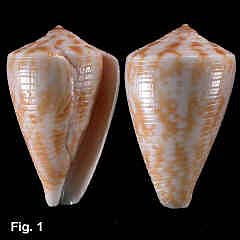|
|
|
|
|
Conus cyanostoma A.Adams, 1854 Description: Shell moderately heavy with convex sides. Entire body whorl sculptured with 16-24 strong, regular, spiral grooves, wider and more widely spaced posteriorly, occasionally missing from top third or half; a few more closely spaced spiral ribs at base. Shoulder angled, spire moderately high, straight or weakly concave. Spire whorls straight with 2-4 major ribs per whorl, and sometimes several additional weaker ribs. Aperture almost constant width, outer lip convex. Background colour white or cream, ornamented with irregular patches of orange-brown, formed into three spiral bands at the shoulder, midbody and base. Aperture white, bluish-grey or pink. Size: Up to about 24 mm in length. Distribution: Endemic to Australia; Keppel Bay, Queensland, to Sydney, NSW. Habitat: Known mainly from beach shells, but also from specimens trawled in 10-183 metres. South of Trial Bay, NSW, it is only known from subtidal specimens. It is not taken alive intertidally, so apparently lives in the shallow sub-tidal and below. Very uncommon. Comparison: See C. sydneyensis. Synonym: Conus coxeni Brazier, 1875; Conus innotabilis E.A. Smith, 1892 Remarks: The strength of sculpture is quite variable. Shallow water shells tend to have weak sculpture, with the top of the body whorl smooth, while deeper water shells have spiral grooves over the whole whorl, but this feature is not consistent. Fig. 1 Trial Bay, NSW (C.028476) |
